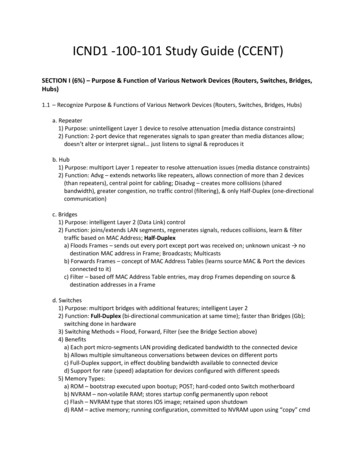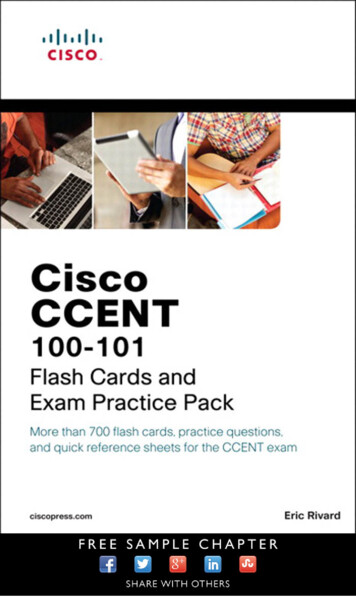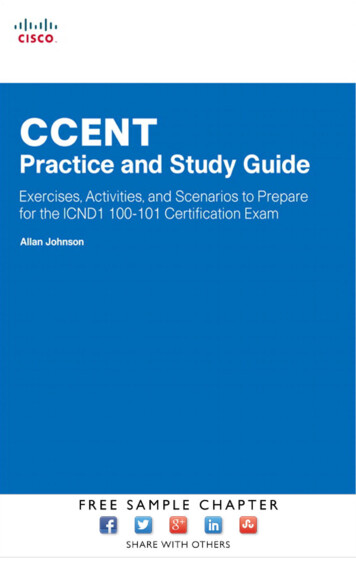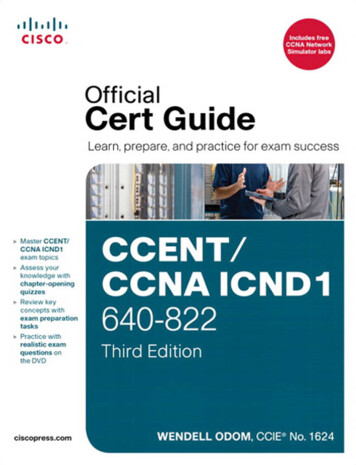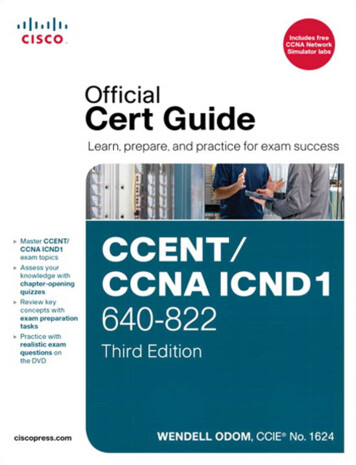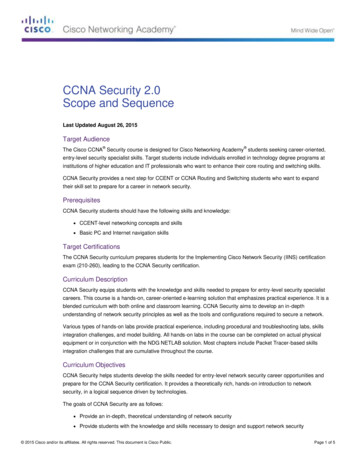
Transcription
31 Days Before YourCCENT CertificationScott BennettCisco Press 800 East 96th Street Indianapolis, Indiana 46240 USA
ii31 Days Before Your CCENT Certification31 Days Before Your CCENT CertificationScott BennettCopyright 2008 Cisco Systems, Inc.Published by:Cisco Press800 East 96th StreetIndianapolis, IN 46240 USAAll rights reserved. No part of this book may be reproduced or transmitted in any form or by any means,electronic or mechanical, including photocopying or recording, or by any information storage andretrieval system, without written permission from the publisher, except for the inclusion of briefquotations in a review.First Printing December 2007Library of Congress Cataloging-in-Publication Number:Bennett, Scott, CCNA.31 days before your CCENT certification / Scott Bennett.p. cm.ISBN 978-1-58713-217-9 (pbk.)1. Electronic data processing personnel—Certification. 2. Computer networks—Examinations—Studyguides. I. Title. II. Title: Thirty-one days before your CCENT certification.TK5105.5.B443 2007004.6076—dc222007048436ISBN-13: 978-1-58713-217-9ISBN-10: 1-58713-217-6Warning and DisclaimerThis book is designed to provide information about the Cisco Networking Academy Program CCNADiscovery curriculum. Every effort has been made to make this book as complete and accurate as possible, but no warranty or fitness is implied.The information is provided on an “as is” basis. The author, Cisco Press, and Cisco Systems, Inc. shallhave neither liability nor responsibility to any person or entity with respect to any loss or damages arising from the information contained in this book or from the use of the discs or programs that mayaccompany it.The opinions expressed in this book belong to the author and are not necessarily those of Cisco Systems,Inc.
iiiFeedback InformationAt Cisco Press, our goal is to create in-depth technical books of the highest quality and value.Each book is crafted with care and precision, undergoing rigorous development that involves theunique expertise of members of the professional technical community.Reader feedback is a natural continuation of this process. If you have any comments about how wecould improve the quality of this book, or otherwise alter it to better suit your needs, you can contact us through e-mail at feedback@ciscopress.com. Please be sure to include the book title andISBN in your message.We greatly appreciate your assistance.PublisherPaul BogerAssociate PublisherDavid DusthimerCisco RepresentativeAnthony WolfendenCisco Press Program ManagerJeff BradyExecutive EditorMary Beth RayManaging EditorPatrick KanouseSenior Development EditorChristopher ClevelandSenior Project EditorTonya SimpsonCopy EditorGayle JohnsonTechnical EditorsGlenn Tapley, Glenn WrightTeam CoordinatorVanessa EvansBook and Cover DesignerLouisa AdairCompositionTrudy ColerIndexerKen JohnsonTrademark AcknowledgmentsAll terms mentioned in this book that are known to be trademarks or service marks have beenappropriately capitalized. Cisco Press or Cisco Systems, Inc. cannot attest to the accuracy of thisinformation. Use of a term in this book should not be regarded as affecting the validity of anytrademark or service mark.
iv31 Days Before Your CCENT CertificationAbout the AuthorScott Bennett earned his CCNA, CCAI, and CompTIA A while working and teaching in thetechnology industry. After graduating from Gonzaga University, he went on to work with QwesteBits, providing network support and training to businesses throughout Idaho. He has four years ofexperience as a Cisco Networking Academy instructor for the Capital Center High SchoolTechnology Institute and Portland Community College. He also wrote 31 Days Before Your CCNAExam.About the Technical ReviewersGlenn Tapley works as a technical education consultant for Cisco. Glenn has been with Cisco formore than eight years and works on certification courses and exams and is a regular speaker at theannual Networkers and Cisco Live conferences. Prior to Cisco, Glenn was a Certified CiscoSystems instructor for several years with Chesapeake Computer Consultants, Inc., of Annapolis,Maryland. Glenn lives in Florida with his wife and two daughters.Glenn Wright, CCNA, CCAI, is the codirector of the Cisco Academy Training Center (CATC) inFort Worth, Texas. He has a bachelor’s degree in business education from the University of NorthTexas and 22 years of experience in computer education. He has been involved in many aspects ofthe Cisco Networking Academy since 1999. He serves the Academy as an instructor and supportsthe Regional Academies in Texas, Louisiana, Oklahoma, Arkansas, North Carolina, SouthCarolina, Virginia, and Tennessee. He also has worked with the Academy Quality Assurance Team,reviewing and editing Academy curriculum and assessment.
vDedicationTo Grandpa Matt; my loving and supportive parents, Jim and Shari; my energetic and caring siblings, Jimmy, Johnny, Monnie, and Christi; and Pam and George for creating my beloved beautifulwife, Angie.
vi31 Days Before Your CCENT CertificationAcknowledgmentsFirst, I want to thank Mary Beth Ray for her help in this process from start to finish. Her ability toenthusiastically adapt to the ever-changing Cisco certification and Cisco Academy environmentamazes me. Thank you for this remarkable experience and opportunity. Thank you to the entireCisco Press team who worked behind the scenes to help create this book.I also need to thank Matt Schoenfeldt for his continued and contagious eccentric passion about allthings technical. Thanks to Gary Schlienkofer for his work as a regional director and as an instructor for our local Cisco Networking Academy. I also want to thank my friend Peter Buss for providing the perspective and empathy of a seasoned network administrator. Finally, I want to thankCoach Dan Gehn for teaching me the real meaning of the words endurance and dedication.
viiContents at a GlancePart I: Days 31–27 Describe the operation of data networksDay 313Day 307Day 2913Day 2821Day 2733Part II: Days 26–21: Implement a small switched networkDay 2639Day 2545Day 2449Day 2353Day 2257Day 2161137Part III: Days 20–13: Implement an IP addressing scheme andIP services to meet network requirements for a smallbranch office 65Day 2067Day 1973Day 1877Day 1781Day 1685Day 1589Day 1493Day 1395Part IV: Days 12–8: Implement a small routed networkDay 1299Day 11105Day 1010797
viii31 Days Before Your CCENT CertificationDay 9111Day 8115Part V: Days 7–6: Explain and select the appropriate administrative tasksrequired for a WLAN 119Day 7121Day 6127Part VI: Days 5–4: Identify security threats to a network and describe general methods to mitigate those threats 131Day 5133Day 4137Part VII: Days 3–1: Implement and verify WAN links and reviewall days 141Day 3143Day 2147Day 1151Part VIII: Exam and post exam daysExam Day187Post-Exam Information189185
ixContentsPart I: Days 31–27: Describe the operation of data networks1Day 31: Describe the Purpose and Functions of Various Network DevicesCCNA Discovery 1, Chapter 13CCNA Discovery 1, Chapter 34Select the Components Required to Meet a Given Network SpecificationCCNA Discovery 1, Chapter 3SummaryYour Notes34555Day 30: Use the OSI and TCP/IP Models and Their Associated Protocols to ExplainHow Data Flows in a Network7CCNA Discovery 1, Chapter 67CCNA Discovery 2, Chapter 210Describe Common Networking Applications, Including Web ApplicationsCCNA Discovery 1, Chapter 1SummaryYour Notes11111112Day 29: Describe the Purpose and Basic Operation of the Protocols in the OSI andTCP Models13CCNA Discovery 1, Chapter 313CCNA Discovery 1, Chapter 614CCNA Discovery 2, Chapter 715Describe the Impact of Applications (Voice over IP and Video over IP) on aNetwork 18CCNA Discovery 2, Chapter 318CCNA Discovery 2, Chapter 718SummaryYour Notes1919
x31 Days Before Your CCENT CertificationDay 28: Interpret Network DiagramsCCNA Discovery 1, Chapter 321CCNA Discovery 2, Chapter 123CCNA Discovery 2, Chapter 32421Determine the Path Between Two Hosts Across a NetworkCCNA Discovery 1, Chapter 32424CCNA Discovery 1, Chapter 425CCNA Discovery 2, Chapter 126Describe the Components Required for Network and InternetCommunications 27CCNA Discovery 1, Chapter 327CCNA Discovery 1, Chapter 429CCNA Discovery 2, Chapter 129CCNA Discovery 2, Chapter 329SummaryYour Notes3031Day 27: Identify and Correct Common Network Problems at Layers 1, 2, 3, and 7Using a Layered Model Approach33CCNA Discovery 1, Chapter 933CCNA Discovery 2, Chapter 234Differentiate Between LAN/WAN Operation and FeaturesCCNA Discovery 1, Chapter 335CCNA Discovery 1, Chapter 435CCNA Discovery 2, Chapter 535SummaryYour Notes353636Part II: Days 26–21: Implement a small switched network37Day 26: Select the Appropriate Media, Cables, Ports, and Connectors to ConnectSwitches to Other Network Devices and Hosts 39CCNA Discovery 1, Chapter 339CCNA Discovery 1, Chapter 439CCNA Discovery 2, Chapter 341SummaryYour Notes4243
xiDay 25: Explain the Technology and Media Access Control Method for EthernetTechnologies 45CCNA Discovery 1, Chapter 345Explain Network Segmentation and Basic Traffic Management ConceptsCCNA Discovery 1, Chapter 3SummaryYour Notes46474747Day 24: Explain the Operation of Cisco Switches and Basic SwitchingConcepts 49CCNA Discovery 1, Chapter 349CCNA Discovery 2, Chapter 350CCNA Discovery 2, Chapter 550SummaryYour Notes5051Day 23: Perform, Save, and Verify Initial Switch Configuration Tasks, IncludingRemote-Access Management 53CCNA Discovery 2, Chapter 553Verify Network Status and Switch Operation Using Basic Utilities(ping, traceroute, Telnet, SSH, ARP, ipconfig, show, and debugCommands) 55CCNA Discovery 1, Chapter 955CCNA Discovery 2, Chapter 555SummaryYour Notes5656Day 22: Implement and Verify Basic Security for a Switch (Port Security,Deactivate Ports) 57CCNA Discovery 2, Chapter 5SummaryYour Notes575859Day 21: Identify, Prescribe, and Resolve Common Switched Network Issues,Autonegotiation, and Switch Hardware Failures 61CCNA Discovery 1, Chapter 961CCNA Discovery 2, Chapter 261CCNA Discovery 2, Chapter 561SummaryYour Notes6263
xii31 Days Before Your CCENT CertificationPart III: Days 20–13: Implement an IP addressing scheme andIP services to meet network requirements for a small branchoffice 65Day 20: Describe the Need for and Role of Addressing in a NetworkCCNA Discovery 1, Chapter 267CCNA Discovery 1, Chapter 567Create and Apply an Addressing Scheme to a NetworkCCNA Discovery 1, Chapter 569CCNA Discovery 2, Chapter 470SummaryYour Notes67687272Day 19: Assign and Verify Valid IP Addresses to Hosts, Servers, and NetworkingDevices in a LAN 73CCNA Discovery 1, Chapter 273CCNA Discovery 1, Chapter 573CCNA Discovery 2, Chapter 574SummaryYour Notes7475Day 18: Explain the Basic Uses and Operation of NAT in a Small NetworkConnecting to One ISP 77CCNA Discovery 1, Chapter 577CCNA Discovery 2, Chapter 477CCNA Discovery 2, Chapter 579SummaryYour Notes8080Day 17: Describe and Verify DNS OperationCCNA Discovery 1, Chapter 981CCNA Discovery 2, Chapter 781SummaryYour Notes818383Day 16: Describe the Operation and Benefits of Using Private and Public IPAddressing 85CCNA Discovery 1, Chapter 585Enable NAT for a Small Network with a Single ISP and Connection Using SDM,and Verify Operation Using CLI and Ping 86
xiiiCCNA Discovery 2, Chapter 5SummaryYour Notes868787Day 15: Configure, Verify, and Troubleshoot DHCP and DNS Operation on a Router(Including CLI/SDM) 89CCNA Discovery 1, Chapter 589CCNA Discovery 2, Chapter 590SummaryYour Notes9191Day 14: Implement Static and Dynamic Addressing Services for Hosts in a LANEnvironment 93CCNA Discovery 1, Chapter 293CCNA Discovery 1, Chapter 593SummaryYour Notes9494Day 13: Identify and Correct IP Addressing IssuesCCNA Discovery 1, Chapter 995CCNA Discovery 2, Chapter 295SummaryYour Notes959696Part IV: Days 12–8: Implement a small routed network97Day 12: Describe Basic Routing Concepts (Packet Forwarding, Router LookupProcess) 99CCNA Discovery 2, Chapter 699Describe the Operation of Cisco Routers (Router Bootup Process, POST, RouterComponents) 101CCNA Discovery 2, Chapter 5101Select the Appropriate Media, Cables, Ports, and Connectors to Connect Routersto Other Network Devices and Hosts 102CCNA Discovery 2, Chapter 5SummaryYour Notes103103102
xiv31 Days Before Your CCENT CertificationDay 11: Configure, Verify, and Troubleshoot RIPv2CCNA Discovery 2, Chapter 6SummaryYour Notes105105106106Day 10: Access and Use the Router CLI to Set Basic ParametersCCNA Discovery 2, Chapter 5107107Connect, Configure, and Verify the Operation Status of a Device InterfaceCCNA Discovery 2, Chapter 5108108Verify Device Configuration and Network Connectivity Using ping, traceroute,Telnet, SSH, or Other Utilities 109CCNA Discovery 2, Chapter 5SummaryYour Notes110110110Day 9: Perform and Verify Routing Configuration Tasks for a Static or DefaultRoute Given Specific Routing Requirements 111CCNA Discovery 2, Chapter 5111CCNA Discovery 2, Chapter 6111Manage IOS Configuration Files (Save, Edit, Upgrade, Restore)CCNA Discovery 2, Chapter 5Manage Cisco IOS112113CCNA Discovery 2, Chapter 5113Implement Password and Physical SecurityCCNA Discovery 2, Chapter 3113CCNA Discovery 2, Chapter 5113SummaryYour Notes112113114114Day 8: Verify Network Status and Router Operation Using Basic Utilities (ping,traceroute, Telnet, SSH, ARP, ipconfig, show, and debug Commands) 115CCNA Discovery 1, Chapter 9115CCNA Discovery 2, Chapter 5115CCNA Discovery 2, Chapter 6116SummaryYour Notes116117
xvPart V: Days 7–6: Explain and select the appropriateadministrative tasks required for a WLAN 119Day 7: Describe Standards Associated with Wireless Media (Including the IEEEWi-Fi Alliance and ITU/FCC) 121CCNA Discovery 1, Chapter 7121Identify and Describe the Purposes of the Components of a Small WirelessNetwork (Including SSID, BSS, ESS) 122CCNA Discovery 1, Chapter 7122Identify the Basic Parameters to Configure on a Wireless Network to Ensure ThatDevices Connect to the Correct Access Point 124CCNA Discovery 1, Chapter 7SummaryYour Notes124125126Day 6: Compare and Contrast Wireless Security Features and Capabilities of WPASecurity (Including Open, WEP, WPA1/2) 127CCNA Discovery 1, Chapter 7127CCNA Discovery 2, Chapter 8128Identify Common Issues with Implementing Wireless NetworksCCNA Discovery 1, Chapter 7129CCNA Discovery 1, Chapter 9129SummaryYour Notes129130130Part VI: Days 5–4: Identify security threats to a network anddescribe general methods to mitigate those threats 131Day 5: Explain Today’s Increasing Network Security Threats and the Need toImplement a Comprehensive Security Policy to Mitigate the Threats 133CCNA Discovery 1, Chapter 8133CCNA Discovery 2, Chapter 8134Explain General Methods to Mitigate Common Security Threats to NetworkDevices, Hosts, and Applications 135CCNA Discovery 1, Chapter 8SummaryYour Notes136136135
xvi31 Days Before Your CCENT CertificationDay 4: Describe the Functions of Common Security Appliances andApplications 137CCNA Discovery 1, Chapter 8137CCNA Discovery 2, Chapter 8138Describe Security Recommended Practices, Including Initial Steps to SecureNetwork Devices 139CCNA Discovery 1, Chapter 8139CCNA Discovery 2, Chapter 8139SummaryYour Notes139140Part VII: Days 3–1: Implement and verify WAN links and reviewall days 141Day 3: Describe Different Methods of Connecting to a WANCCNA Discovery 2, Chapter 5143Configure and Verify a Basic WAN Serial ConnectionCCNA Discovery 2, Chapter 5SummaryYour NotesDay 2143144144145145147CCNA Discovery 1 Packet Tracer Activity Checklist147CCNA Discovery 2 Packet Tracer Activity Checklist147SummaryYour Notes148149Day 1: Review Detail Charts, Lists, and Concepts from Previous DaysDay 31: Network Components and OperationDay 30: Layered Model Applications151152Day 29: Layered Model Protocols and Their PurposesDay 28: Network Diagrams and ComponentsDay 27: Troubleshooting and LAN Versus WANDay 26: Network Physical Media154155156Day 25: Media Access Control and SegmentationDay 24: Switch Operation157Day 23: Switch Configuration158157152151
xviiDay 22: Switch Security158Day 21: Switch TroubleshootingDay 20: IP Addressing159Day 19: Assign AddressesDay 18: NAT159160161Day 17: DNS Operation161Day 16: Private Networks and NATDay 15: DHCP Operation162162Day 14: Static and Dynamic AddressingDay 13: IP Address TroubleshootingDay 12: Routing and RoutersDay 11: RIP ConfigurationDay 10: CLI Parameters163164166166Day 9: Configuration, IOS, and SecurityDay 8: Network Status VerificationDay 7: Wireless StandardsDay 6: Wireless SecurityDay 5: Security Threats168169170171172Day 4: Security ApplicationsDay 3: WAN ConnectionsSummary163173174175Your Notes or Personal Day 1 Outline175Part VIII: Exam and post exam daysExam Day185187What You Need for the Exam187What You Should Receive After CompletionSummary188Post-Exam Information189Receiving Your CertificateDetermining Career Options189189187
xviii31 Days Before Your CCENT CertificationExamining Certification OptionsIf You Fail the ExamSummaryYour Notes190191190190
xixIcons Used in This BookWorkstationHubNetwork CloudFile ine: EthernetLine: SerialMultilayer SwitchLaptopCiscoIP PhoneRouterPipeLine: Circuit-SwitchedCommand Syntax ConventionsThe conventions used to present command syntax in this book are the same conventions used inthe IOS Command Reference. The Command Reference describes these conventions as follows: Boldface indicates commands and keywords that are entered literally as shown. In actual configuration examples and output (not general command syntax), boldface indicates commandsthat are manually input by the user (such as a show command). Italic indicates arguments for which you supply actual values. Vertical bars ( ) separate alternative, mutually exclusive elements. Square brackets ([ ]) indicate an optional element. Braces ({ }) indicate a required choice. Braces within brackets ([{ }]) indicate a required choice within an optional element. A command that does not fit on one line continues on the next line with a two-space indent.
xx31 Days Before Your CCENT CertificationIntroduction31 Days Before Your CCENT Certification represents the end of your adventure through the CiscoNetworking Academy CCNA Discovery courses. It’s time to pass the ICND1 640-822 exam andmake your knowledge official. You owe it to yourself to complete your current Cisco NetworkingAcademy studies with a CCENT certification. This book essentially provides a bridge between theCisco Networking Academy curriculum and the CCENT (ICND1) exam. Each day breaks downeach exam topic into a manageable bite using short summaries from the online curriculum. Usethis book and its organized course of study to take the guesswork out of your comprehensiveNetworking Academy review for the CCENT.Goals and MethodsThe main goal of this book is to provide you with a clear map from the Cisco NetworkingAcademy online curriculum to the CCENT (ICND1) exam. You will read short summaries of sections from the Networking Academy online curriculum as they relate to each of the exam topicsfor the CCENT. This book also outlines the format of the CCENT exam and the registrationrequirements you must fulfill to take the CCENT (ICND1) exam.Each day in this book uses the following elements to review the Cisco Networking Academyonline curriculum: Short summaries of key concepts and definitions from the curriculum, with a reference to theNetworking Academy online module section number. Tables and figures to help you recognize topics that you covered during your NetworkingAcademy studies. No-frills Cisco IOS Software command-line examples to jog your memory about the configurations and lab exercises that relate to each CCENT objective. References for further study and practice testing with the CCNA Flash Cards and ExamPractice Pack. Brief attempts at networking humor.This book can also provide instructors and students with a concise way to review the CCNADiscovery curriculum and add a little personality and a new angle to the Networking Academycurriculum. You can use this book to fit CCENT studies into an otherwise busy schedule with adaily timeline and clear references to other CCENT study materials.Who Should Read This Book?The primary audience for this book is anyone teaching or enrolled in the Cisco NetworkingAcademy CCNA Discovery courses or recent graduates of the Cisco Networking Academy CCNADiscovery curriculum who have not yet taken or passed the CCENT (ICND1) exam.The secondary audience for this book is anyone who wants to review for the CCENT, whichassumes some prior networking knowledge.
xxiHow This Book Is OrganizedThis book begins with instructions leading you through the process to register for the CCENTexam. Then it breaks up the exam topics by day. The book counts down starting with Day 31 andcontinues through exam day to provide post-test information. Each day includes subheadings thatidentify the exam topics that are covered. Each curriculum summary provides the module andsection from the corresponding CCNA Discovery course.You will also find a calendar and checklist that you can tear out and use during your exam preparation. Use the calendar to enter each actual date beside the countdown day, and the day, time,and location of your CCENT exam. The calendar provides a visual for how much time you candedicate to each CCENT (ICND1) exam objective. You can also put a red X over each day youcomplete, like those movie montages where the lead character is preparing for something important. Use the checklist to map out your studies leading up to the CCENT (ICND1) exam. Thechecklist highlights important tasks and deadlines leading up to your exam.Study TipsIt might help to buy a whiteboard. Get a dry-erase marker and fill the room with that awful scentwhile you diagram and teach yourself each concept. Teach out loud. Teach whoever will listen.Most important, you need to inject yourself into this information. Your desire to get a CCENT andunderstand these concepts will shine through on test day. If you cannot explain and diagram anobjective, you do not know it. The real test happens when your boss asks you to explain a networking concept or to defend your suggestion in a meeting. The following activities can also helpyou prepare: Podcast audio discussions about CCENT topics. Capture video lessons of yourself, and watch them or place them online for others. For every hour that you study, donate a set amount to a children’s hospital. Ask friends tosponsor you. Blog what you are learning. Get a copy of CCNA Flash Cards and Exam Practice Pack, and tackle the suggested readingsand practice exams for each day.
xxii31 Days Before Your CCENT CertificationGetting to Know the CCENT (ICND1 640-822)ExamThe CCENT ICND1 640-822 exam tests your ability to describe, implement, configure, secure,and troubleshoot small networks. Just knowing the information will help you on the exam, but alsoknowing the testing process, format, and testing environment will build your confidence andreduce the chance of any unpleasant surprises on exam day.Exam TopicsThe topics of the CCENT (ICND1 640-822) exam focus on the following seven key categories: Describe network operation: The topics in this category relate to the theory and conceptsbehind networks, including layered models, protocols, and topologies. Implement a switched network: This category asks you to connect, configure, and secure aswitched network. Implement an IP addressing scheme: This category asks you to describe subnetting, NAT,DHCP, DNS, and IP addressing-related tasks on a network. Implement a routed network: This category asks you to connect, configure, and secure arouter on a network. Explain and select administrative tasks for a WLAN: This category is where you provethat you understand the different WLAN standards and necessary parameters to configure ona WLAN. Identify and mitigate security threats: This category asks you to describe common networkvulnerabilities and how to protect your users and data. Implement and verify WAN links: This category asks you to describe WAN connections andconfigure a basic WAN serial connection.Each category includes general exam topics. In this book, similar CCENT (ICND1) exam topicsare grouped into a single day and are explained using the information you have learned in theCCNA Discovery courses.Although Cisco outlines general exam topics, it is possible that not all topics will appear on theCCENT (ICND1) exam and that topics that are not specifically listed may appear on the exam.The exam topics provided by Cisco and included in this book are a general framework for exampreparation. Be sure to check Cisco.com and look at the latest exam topics. You can navigate toCCENT information through the Training and Events link.
xxiiiExam FormatFor the CCENT (ICND1) exam, you are allowed 90 minutes to answer 50 to 60 questions.Table I-1 outlines each type of question that you might encounter on the exam.Table I-1Cisco Exam Question TypesQuestion TypeDescriptionMultiple-choice single-answerYou choose one and only one answer.Multiple-choice multiple-answeryou how many answers you must select.You choose more than one answer. The question tellsDrag-and-dropYou drag and release objects to visually arrange theanswer on the page. These questions are similar to the drag-anddrop Interactive Media Activities in the Academy onlinecurriculum.Fill-in-the-blankYou click a text box and then enter the answer. Sometimes thereis more than one text box.TestletYou see an upper pane and lower pane in the main window for this type of task. The upper pane contains ascenario, and the lower pane contains multiple-choice questionswith single and multiple answers. On the right side you canscroll through the scenario and select questions.SimletA top pane contains questions, and a bottom panecontains a router simulation that you can use to answerthe questions.SimulationsThis task is similar to the e-Labs that cover configurations.Remember that not all commands are supported in thesesimulations and that you can view the network topology insome simulations. You see the actual problem at the top and thedirections on the left.Cisco.com has an exam tutorial that simulates each of these types of questions. As you workthrough the exam tutorial, identify the question types that will take you longer to complete so thatyou can manage your time on exam day. The following steps allow you to access this tutorial:Step 1Visit http://www.vue.com/cisco.Step 2Scroll down and visit the link labeled Review the Cisco CertificationExam Tutorial.Step 3Click the Certification Exam Tutorial link.
xxiv31 Days Before Your CCENT CertificationICND1 640-822 Discount VoucherAs a Cisco Networking Academy student, you have a unique opportunity to integrate your finaldays of study with preparation for the CCENT exam. Before you complete the CCNA Discovery 2course (Working at a Small-to-Medium Business or ISP), you should plan to pass the final examwith a 75% or higher on the first attempt. If you do so, you can request a discount voucher forthe ICND1 exam on your Cisco Networking Academy home page. It is important to schedule theCCNA Discovery 2 final so that you have time to properly prepare and achieve a 75% or higher onyour first attempt. Work with your instructor to choose an optimal time and environment to takethe final.Registering for the CCENT (ICND1 640-822) ExamAfter you have taken the final and redeemed your voucher, you need to gather the information outlined in Table I-2 to register for the ICND 640-822 exam.Table I-2Personal Information for ICND 640-822 Exam RegistrationItemNotesLegal nameSocial security or passport numberCisco certification ID or test IDCisco Academy usernameRequired for your voucherCisco Academy ID numberRequired for your voucherCompany nameValid e-mail addressVoucher numberRequired for your voucherMethod of paymentTypically a credit cardYou can register for an exam up to six weeks in advance or as late as the day before the exam. Ifyou had an account with the Pearson VUE before you began with the Networking Academy, it isimportant to ensure that your profile is updated with your Academy information for the Academyvoucher before you register. You can contact Pearson VUE as shown in Table I-3 to register for anexam. The process and available test times vary based on the local testing center you choose.Table I-3Test Delivery PartnersTesting PartnerPearson VUEPhone NumberWebsiteIn the U.S. and Canada,call 1-800-829-6387. Chooseoption 1 and then option 4.Check the website for informationfor other countries.http://www.vue.com/ciscoThere is no better motivation for study than an actual test date. Sign up as soon as you have yourvoucher.
Day 6Compare and Contrast WirelessSecurity Features and Capabilitiesof WPA Security (Including Open,WEP, WPA1/2)An unsecured wireless network provides easy access for all users in range, including unauthorized,unwelcome, and possibly evil users. Wireless security features can help you keep the evil out ofyour network. Chapter 7 of CCNA Discovery 1 and Chapter 8 of CCNA Discovery 2 discuss methods available to better secure a WLAN.CCNA Discovery 1, Chapter 77.3.1 and 7.3.2: Unauthorized users attempt to tap into a wireless LAN to obtain free Internetservice and possibly steal data from the WLAN. Often an AP signal reaches outside a building orthe desired range of the administrator. To avoid malicious war drivers or war walkers, an administrator should implement the following security features on a WLAN during initial setup: SSID broadcast: You can disable the SSID broadcast feature and require anyone connectingto the network to know the broadcast SSID. However, the SSID is transmitted in clear text, soit is not difficult to discover the SSID for a network. Default settings: You can change the default settings on your AP, including usernames,
guides. I. Title. II. Title: Thirty-one days before your CCENT certification. TK5105.5.B443 2007 004.6076—dc22 2007048436 ISBN-13: 978-1-58713-217-9 ISBN-10: 1-58713-217-6 Warning and Disclaimer This book is designed to provide information about the Cisco Networking Academy Program CCNA Discovery curriculum.


